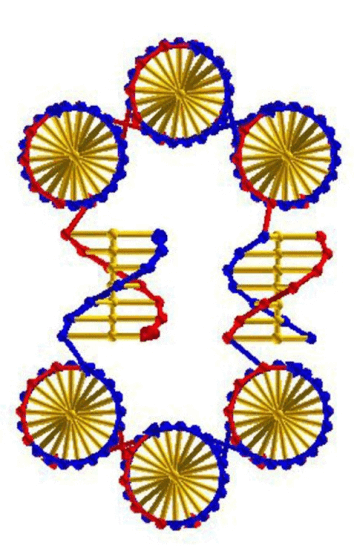The new discovery constitutes the first steps towards a general process of self-replication of a wide variety of structures

Scientists from New York University have succeeded in preparing artificial structures capable of self-replication, a process that has the potential to develop new types of materials. In the natural world, self-replication exists in all living things, but the ability for man-made self-replication has so far been an elusive goal. The new discovery constitutes the first steps towards a general process of self-replication of a wide variety of structures. These structures are based on the building blocks of DNA, which function as letters that are organized to form a defined word. The duplication process preserves the letter sequence and shape
The study, conducted by researchers from the departments of chemistry and physics at New York University, appears in the latest issue of the prestigious scientific journal Nature.
This process holds great promise for the creation of new materials. DNA is a stable functional structure capable of organizing itself as well as other molecules into complex structures. Recently, DNA is also used for the arrangement of inorganic material such as metallic particles. The laboratory imitation of this natural organization process by New York University scientists gives rise to the possibility of the final development of self-replicating materials that include a wide variety of patterns capable of performing a multitude of functions. The breakthrough achieved by the researchers is the replication of a system that includes complex information. Therefore, the replication of this substance, similar to that of the DNA found in the cell, is not limited to repetitive patterns.
In order to demonstrate this self-replication process, the researchers created artificial DNA-like building blocks - short, nanometer arrays of DNA. Each building block functions as a letter - A or B - that identifies and connects to complementary letters A' or B', respectively. In the natural world, the DNA replication process includes the complementary matching of four bases - adenine that binds to yman and guanine that binds to cytosine - to create the double helix that we all know. Contrary to this, the researchers developed artificial building blocks called BTX (Bent Triple Helix = bent triple helix molecules containing three double helixes of DNA) where each such BTX molecule consists of ten DNA helices. Unlike DNA, the BTX cipher is not limited to just four letters - in principle, it is capable of containing millions upon millions of different letters and building blocks that bind together while taking advantage of the compatibility and complementarity of four separate DNA helices, or as they are called " sticky ends", to form a six-helix structure.
In order to obtain the self-replication of the arrays of the BTX molecule, a primary nucleus is needed that accelerates the construction of many more identical arrays. This nucleus consists of a sequence of seven building blocks - a world of seven letters. In order to initiate the process of self-replication, the nucleus is put into a chemical solution, where it arranges itself in a complementary way to create a "daughter array" - a world of complementary structures.
In the next step, the daughter array is separated from the solution by heating it to about forty degrees Celsius. This process is repeated over and over again. The daughter array is linked to its complementary building blocks to create a "grandson" array and thus a process of self-replication of the material and the information found in the parent nucleus is obtained - thereby duplicating the original sequence. This process is significantly different from the replication process that occurs in the cell, since no biological components are used, especially enzymes, and even the DNA is artificial.
"This is the first step in the process of creating artificial materials that replicate themselves and have diverse compositions," says Professor Paul Chaikin from the Department of Physics at New York University and one of the co-authors of the article. "The next challenge is to create a process in which self-replication occurs not only for several generations, but is long enough so that exponential growth is obtained."
Although our replication method requires several cycles of thermal and chemical processes, we were able to demonstrate that it is possible to replicate not only molecules such as cellular DNA or RNA, but also defined structures that can in principle be organized in turn into many different shapes, with different functional properties and which can bind to many types And different chemical forms," said Nadrian Seeman, a professor in the Department of Chemistry at New York University and one of the co-authors of the paper.

One response
Well done! Very nice, it's a start!